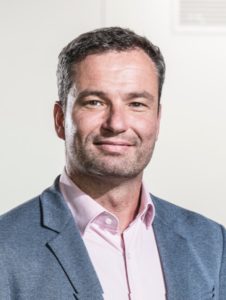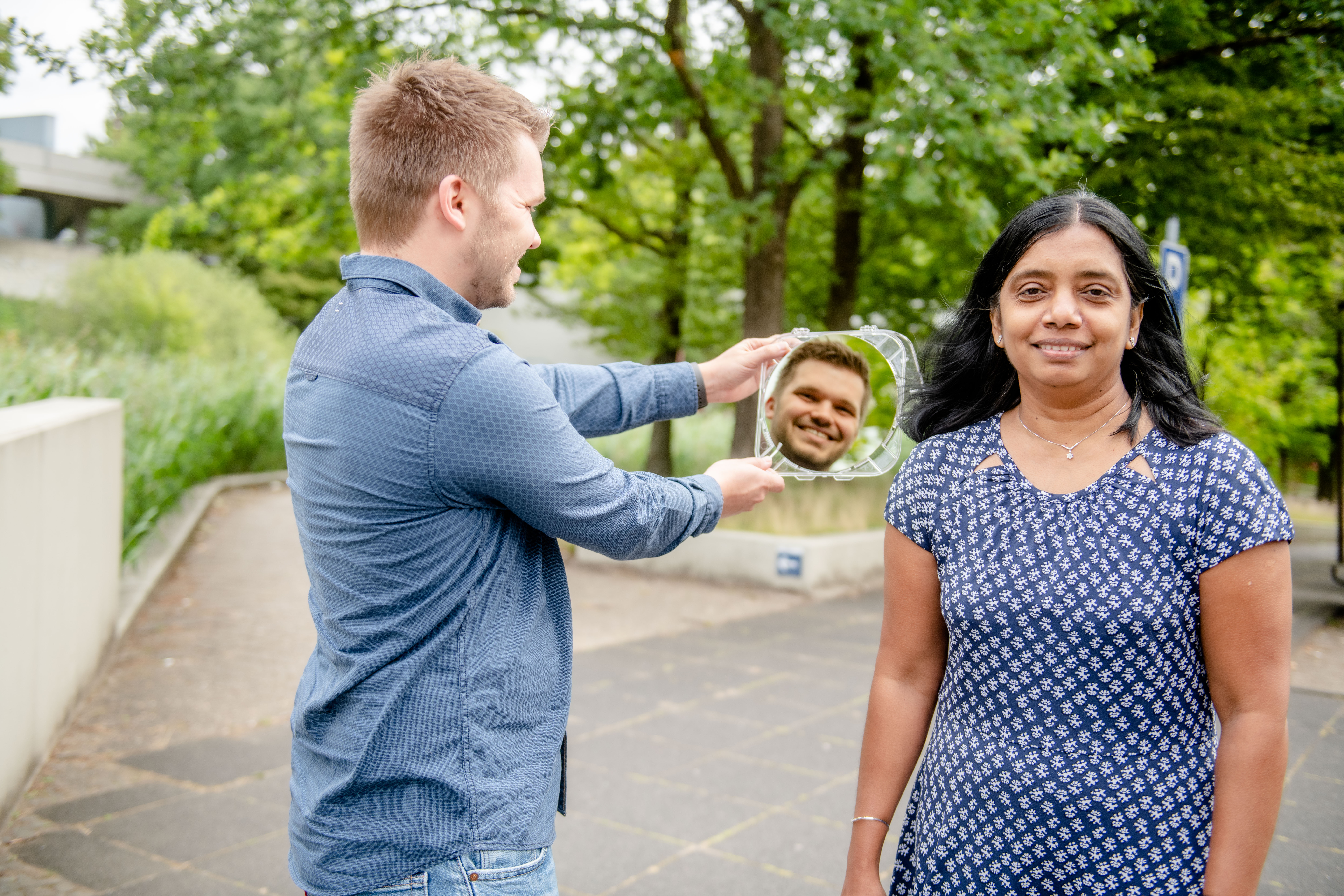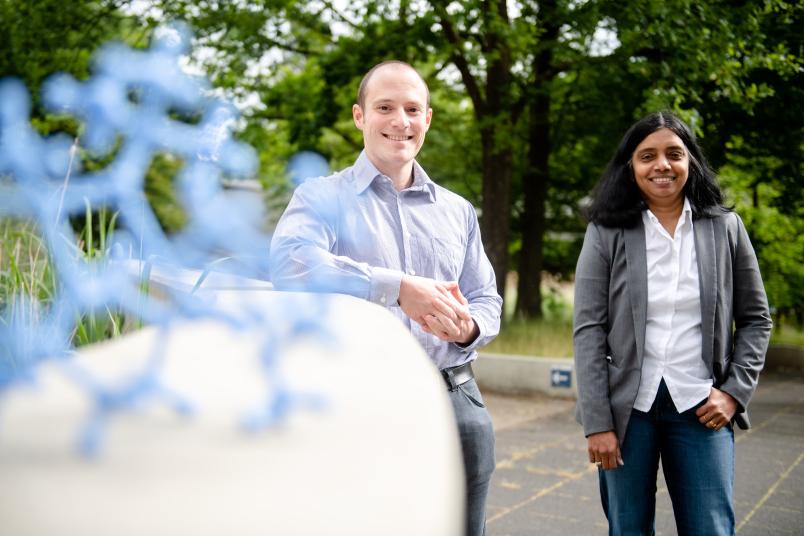Mittwoch, 18. November 2020
Samstag, 11. Juli 2020
2020 Bill Sproul Award and Honorary Lecture Recipient Jochen M. Schneider
 Jochen M. Schneider, Ph.D., is Chair and Professor of Materials Chemistry at RWTH Aachen University, Germany.
Jochen M. Schneider, Ph.D., is Chair and Professor of Materials Chemistry at RWTH Aachen University, Germany.Purpose
The Bill Sproul Award and Honorary ICMCTF lectureship is to recognize the achievements of a mid-career researcher who has made outstanding scientific and/or technological contributions in areas of interest to the Advanced Surface Engineering Division (ASED) of the AVS, with emphasis in the fields of surface engineering, thin films, and related topics.
Find the original Link here.
Lukas Mai and colleagues on new chemistry for ultra-thin gas sensors
 |
| © RUB, Marquard |
A Bochum team has developed a new process for zinc oxide coatings that can be used in nitrogen oxide sensors and as protective coatings on plastics.
The application of zinc oxide coatings in industry is manifold and ranges from the protection of perishable goods from air to the detection of toxic nitrogen oxides. Such layers can be produced by means of atomic layer deposition (ALD), which normally uses precursor chemicals, so-called precursors, which ignite immediately in air. An interdisciplinary research team at the Ruhr-Universität Bochum (RUB) has now established a new production process based on non-self-igniting precursors that takes place at such low temperatures that plastics can also be coated. The team reported in the magazine "Small", which selected the article for its title in the issue of 4 June 2020
Applying ultra-thin coatings.
To produce a sensor for nitrogen dioxide (NO2), a thin layer of nanostructured zinc oxide (ZnO) must be applied to a sensor substrate and then integrated into an electrical component. Prof. Dr. Anjana Devi's team used ALD to apply ultra-thin ZnO layers to such sensor substrates.
In general, ALD processes are used in industry to miniaturize electrical components by means of ultra-thin layers, some of which are only a few atomic layers thick, while at the same time increasing the efficiency. This requires precursors that react on a surface in the ALD process to form a thin layer. "The chemistry behind ALD processes is therefore essential and has a great influence on the resulting layers," emphasizes Anjana Devi.
Safe handling and highest quality
In industry, ZnO coatings have so far been produced with an extremely reactive zinc precursor that ignites immediately in air, experts call it pyrophoric. "The key to developing a safe ALD process was to research a new, non-pyrophoric precursor that can be handled safely and is capable of producing ZnO coatings of the highest quality," said Lukas Mai, lead author of the study. "The challenge was to find an alternative chemistry capable of replacing pyrophoric, industrially used compounds".
The special feature of the new process is that it is even possible at low temperatures, which makes it possible to coat plastics. Thus, the new process is not only suitable for the production of gas sensors, but also for gas barrier layers. These are applied to plastic in industry and are used to protect sensitive goods such as food and medicines from air.
This was made possible by the interdisciplinary cooperation of natural scientists and engineers. The team included the working groups Chemistry of Inorganic Materials headed by Anjana Devi and General Electrical Engineering and Plasma Technology headed by Prof. Dr. Peter Awakowicz, researchers from Heinrich Heine University Düsseldorf and the company Paragon.
The work was funded by the European Fund for Regional Development (EFRE) in the Funald project and by the German Research Foundation in the framework of the Collaborative Research Centre/Transregional TR87. Lukas Mai was supported by the Stiftung der Deutschen Wirtschaft.
~Author Maike Drießen
Montag, 29. Juni 2020
Dr.-Ing. Schmidt is awarded for his outstanding dissertation
 |
| © RUB, Marquard |
Technical plasmas are among the things that have a significant influence on the world around us, without many people knowing about it. "You can, for example, process surfaces with plasmas; but they are crucial in the production of modern computer chips, which are built into almost all modern technical devices - from cars to smart phones," explains Frederik Schmidt. "A better understanding of this technology leads to innovations that make our lives easier, network people and shape our future.
In his dissertation, he investigated how the energy gets into a plasma. The path from the power socket to nanometer-sized semiconductor tracks is being investigated by various specialists and is in part well understood. Frederik Schmidt has brought together two of these specialist areas: the electrical network between the power socket and the plasma on the one hand, and detailed plasma simulations on the other. This makes it possible to investigate the relationship between the two. "For example, I have looked at the paths along which energy flows and how much is lost on its way into the plasma. That is sometimes quite a lot," says the researcher. The results help to make systems and superstructures more efficient and thus more economical and ecological. In addition, he has developed his own electrical network that can be implemented for certain applications with considerably less effort and losses than before. "I was able to show theoretically that this works. Colleagues in France were then able to prove in experiments that it is also practically possible to build something like this," says Schmidt
Montag, 15. Juni 2020
An unusual cobalt compound
 |
| David Zanders and Anjana Devi (right) are happyabouut the extraordinary discovery. © RUB, Marquard |
Searching for small but stable cobalt compounds, a team has discovered a complex that is relevant for material research and exhibits properties that have not been reported for almost 50 years for a compound alike
A research team from Ruhr-Universität Bochum (RUB) and Carleton University in Ottawa has manufactured a novel, highly versatile cobalt compound. The molecules of the compound are stable, extremely compact and have a low molecular weight so that they can be evaporated for the production of thin films. Accordingly, they are of interest for applications such as battery or accumulator production. Because of their special geometry, the compound also has a very unusual spin configuration of ½. A cobalt compound like that was last described in 1972. The team published their report in the journal Angewandte Chemie International Edition from 5 May 2020.
The geometry makes the difference
“The few known cobalt(IV) compounds exhibit high thermal instability and are very sensitive towards air and moisture exposure. This impedes their implementation as model systems for broad reactivity studies or as precursors in material synthesis,” explains lead author David Zanders from the Inorganic Materials Chemistry research group in Bochum, headed by Professor Anjana Devi. In his ongoing binational PhD project, which has been agreed upon by Ruhr University and Carleton University by a Cotutelle agreement, David Zanders and his Canadian colleagues Professor Seán Barry and Goran Bačić discovered a cobalt(IV) compound that does not only possess the aforementioned properties but also exhibits an unusually high stability.
Based on theoretical studies, the researchers demonstrated that a nearly orthogonal embedding of the central cobalt atom in a tetrahedrally arranged environment of connected atoms – so-called ligands – is the key to stabilising the compound. This specific geometric arrangement within the molecules of the new compound also enforces the unusual electron spin of the central cobalt atom. “Under these extraordinary circumstances, the spin can only be ½,” points out David Zanders. A cobalt compound with this spin state and similar geometry has not been described for almost 50 years.
Following a series of experiments, the team also showed that the compound has a high volatility and can be evaporated at temperatures of up to 200 degrees Celsius with virtually no decomposition, which is unusual for cobalt(IV).
Promising candidate for ultra-thin layers
Individual molecules of the compound dock onto surfaces in a controllable manner after evaporation. “Thus, the most fundamental requirement of a potential precursor for atomic layer deposition has been fulfilled,” asserts Seán Barry. “This technique has increasingly gained in importance in industrial material and device manufacturing, and our cobalt(IV) compound is the first of its kind that is fit for this purpose.” “Our discovery is even more exciting as the high-valent oxides and sulfides of cobalt are considered to have great potential for modern battery systems or microelectronics,” adds Anjana Devi. Following frequent charging and discharging, electrodes in rechargeable batteries become more and more unstable, which is why researchers are looking for more stable and, consequently, more durable materials for them. At the same time, they also focus on using new manufacturing techniques.
“This binational collaboration, which was initiated by David Zanders, has pooled the creativity and complementary expertise of chemical engineers from Bochum and Ottawa. All this has produced unexpected results and was certainly the key to success,” concludes Anjana Devi.
~Author: Meike Drießen; Translator Donata Zuber
Mittwoch, 20. Mai 2020
Journal of applied physics honours research of Sebastian Wilczek
 In order to honour particularly outstanding scientific work, the cover
page of each issue is highlighted with grapics by author of an article
in the current issue. The editorial office of the Journal of Applied
Physics chose a cover article of Sebastian Wilczek for the recent volume.
In order to honour particularly outstanding scientific work, the cover
page of each issue is highlighted with grapics by author of an article
in the current issue. The editorial office of the Journal of Applied
Physics chose a cover article of Sebastian Wilczek for the recent volume.
In volume 127 of the journal, the article Electron dynamics in low pressure capacitively coupled radio frequency discharges
of Sebastian Wilczek et al. is published.
The content of the article is the fundamental physics of electron
dynamics in a low pressure electronpositive argon discharge by means of
particle-in-cell/Monte Carlo collisions simulaltions. The interplay
between the fundamental plasma parameters (densities, fields, currents
and temperatures) is explained by analysis with respect to the spartial
and temporal dynamics. Congratulations in the success!
~Marina Prenzel, public relations CRCs
Montag, 9. März 2020
SFB-TR 87 Workshops 25. - 27.03.
Vom 25.03. bis 27.03 finden in Aachen Workshops der Projektbereiche A, B und C statt. Genauere Informationen zum Ablauf des Treffen können folgender Liste entnommen werden:
Dienstag, 25. Februar 2020
Einladung/Invitation: "Autonomous crack healing in MAX phase ceramics"
Die SFB-TR 87 Mitglieder sind herzlich zum Vortrag "Autonomous crack healing in MAX phase ceramics" von Prof. Willem G. Sloof von der Delft University of Technology eingeladen. Dieser findet am Donnerstag den 19.03.2020 um 14 Uhr findet im Rahmen der IGK des SFB-TR 87 in der RWTH Aachen bei Meterials Chemistry statt.
The SFB-TR 87 members are welcomed to attend the talk "Autonomous crack healing in MAX phase ceramics" held by Willem G. Sloof from Delft University of Technology. It takes place on Thursday, the 19th of March, 2020 at 14:00 h, at Materials Chemistry, RWTH Aachen.
The SFB-TR 87 members are welcomed to attend the talk "Autonomous crack healing in MAX phase ceramics" held by Willem G. Sloof from Delft University of Technology. It takes place on Thursday, the 19th of March, 2020 at 14:00 h, at Materials Chemistry, RWTH Aachen.
Freitag, 21. Februar 2020
Plasma workshop at Bo.Ing 2020
 Der SFB-TR 87 und CRC 1316 haben zusammen am Workshop Programm der Bo.Ing 2020 teilgenommen. Auf dem Bochumer Ingenieurstreffen "Bo.Ing", wird Schülern durch Workshops, Laborführungen und Diskussionsrunden ein Einblick in die Ingenieurswisenschaften ermöglicht. Die Veranstaltung wird vom zdi Netzwerk IST.Bochum.NRW organisiert und zusammen mit den Universitäten aus Bochum und Umgebung durchgeführt.
Der SFB-TR 87 und CRC 1316 haben zusammen am Workshop Programm der Bo.Ing 2020 teilgenommen. Auf dem Bochumer Ingenieurstreffen "Bo.Ing", wird Schülern durch Workshops, Laborführungen und Diskussionsrunden ein Einblick in die Ingenieurswisenschaften ermöglicht. Die Veranstaltung wird vom zdi Netzwerk IST.Bochum.NRW organisiert und zusammen mit den Universitäten aus Bochum und Umgebung durchgeführt.
Im Plasma Workshop konnte sechszehn Schülern die Grundlagen von Plasmen und deren Anwendung näher gebracht werden. In praxisorientierten Übungen, waren die Mädchen und Jungs in der Lage selbst Experimente durchzuführen
The SFB-TR 87 and CRC 1316 joined the workshop
program of the Bo.Ing 2020. At the Bochum engineering forum "BO.Ing",
pupils are given an insight into the engineering sciences in workshops,
laboratory tours and discussion groups. The event is organised by the
zdi network IST.Bochum.NRW and is implemented in cooperation with
universities from Bochum and the surrounding area.
With plasma workshop, sixteen pupils in two different workshop
learned the basic ideas about plasma and its applcation. In hands-on
activities, the girls and boys were able to perform their own
experiments.
Abonnieren
Posts (Atom)






